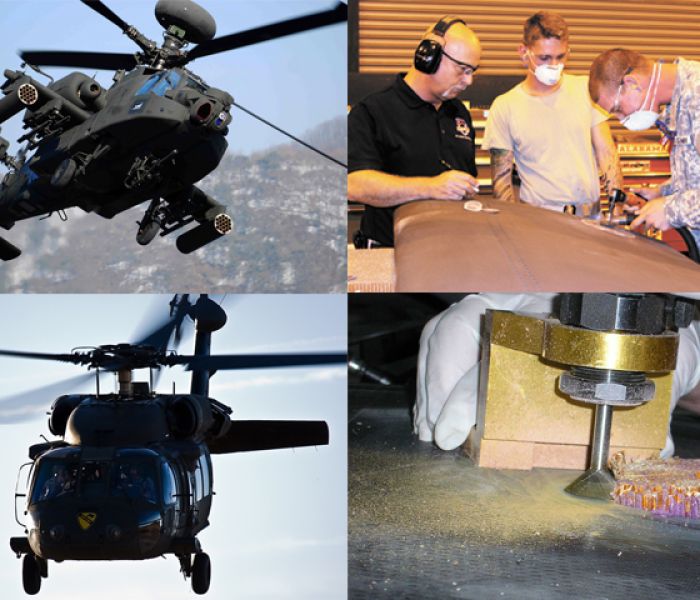In the future, Army aircraft may be made of all composite materials, and the Prototype Integration Facility Advanced Composites Laboratory is ready.
Part of the Aviation and Missile Research Development and Engineering Centre’s, or AMRDEC’s, Engineering Directorate, the Prototype Integration Facility’s, PIF’s, Advanced Composites Lab has successfully designed and made repairs on damaged composite aircraft components for several years now.
From research and development to implementation and rapid prototyping, advancing composites technology is one of AMRDEC’s core competencies that enable the current and future force.
The PIF Advanced Composites Lab is one of several teams at the AMRDEC working with composites, PIF Advanced Composites Lab lead Kimberly Cockrell said;
We have gotten as strong and as light as we can get with metals, and we’re at the end of what metals can economically do. The only way to get stronger and lighter and more capable for the fight is to go to composites.
The PIF team recognised a need for advanced composites repair and began developing a composites capability within the PIF mission to provide rapid response solutions to the war fighter. The program includes repair design and engineering substantiation to show that repaired components are returned to original strength.
Personnel in the Advanced Composites Lab designed and developed repairs for damaged composite stabilisers on the UH-60M Black Hawk helicopter and the AH-64E Apache helicopter. Prior to their repair method, the only way to repair an aircraft with a damaged stabiliser was to pull off the broken stabiliser and replace it with a new one.
Cockrell said the “pull-and-replace” approach was costing the Army up to six figures per stabiliser replacement.
While the first repair procedures were designed for Black Hawk stabilisers, the repair method applies to any solid laminate or sandwich core composite structure, so the procedures and training can be leveraged to other Army aircraft.
Cockrell is proud of the lab’s achievements. Its repair procedures are the first approved repair for primary composite structure on Army aircraft.
With integral support from the AMRDEC’s Aviation Engineering Directorate, the procedures for the composite stabiliser repairs have been written and are undergoing approval for release by the U.S. Army Aviation and Missile Life Cycle Management Command, or AMCOM, Logistics Centre.
An important aspect of developing repair methods is working with the repair personnel who will make the repairs. Members of the PIF Advanced Composites Lab have been training Soldiers on the new stabiliser repair procedures prior to deployment so that they can request approval to use them, on a case-by-case basis, through the Aviation Engineering Directorate.
The lab has also trained the instructors at the 128th Aviation Brigade, as well as the AMCOM logistics assistance representatives.
In addition to training, the PIF Advanced Composites Lab, in partnership with the Aviation Engineering Directorate, played a lead role in developing the Army Technical Manual 1-1500-204-23-11 “Advanced Composite Material General Maintenance and Practices,” as well as in defining the tooling and material load for the new AVIM composites shop set.
The lab is currently working repairs for blades too, as well as just-in-time tooling for parts with complex curves or topography.
And in addition to repair solutions, the lab is using composite materials to create solutions for other issues. For example, it has designed and built a composite doubler to strengthen the hat channels that extend from the hinges of the UH-60 engine cowling.
Photo Credit: U.S. Army photo illustration



Comments